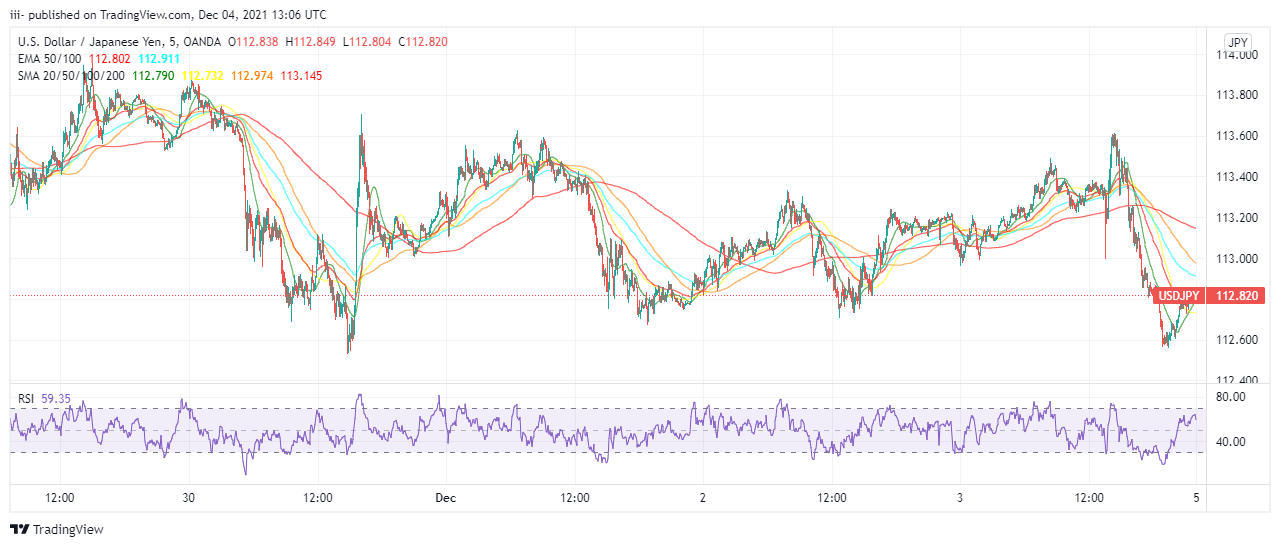The frenzy surrounding the new Omicron variant set the tone for this week’s trade. The long-standing, relatively secure reputation of the Japanese Yen led the USD/JPY downward by 2%, the day’s greatest US Dollar loss.
Except for USD/CAD, where a 12.8% drop in WTI assisted the Dollar’s decline. The 10-year Treasury yield fell 16 basis points to 1.482%.
The marketplace was nervous all week as Omicron incident reports trickled in from various nations and US states, despite no signs of increased danger or vaccination avoidance.
The first mutant virus was detected in South Africa by a doctor who recognized minor instances with no consequences.
The week’s high was 113.66 on Monday, and the week’s low was 112.52 on Tuesday. Wednesday’s closure beneath 113.00 support at 112.81 did not prompt a bid for 112.25.
Markets await news of the new variation. All viruses evolve, and the typical development is toward more transmission and less fatality.
The Federal Reserve Chair’s dual statements that it could be time to remove the ‘transitory’ definition of inflation and that an acceleration of the taper could be in place at the December 15 Federal Open Market Committee (FOMC) conference did not help.
The US nonfarm payroll data on Friday failed to meet its headline projection of 550,000 new jobs, but it showed the labor market’s progress this year.
Unemployment declined to 4.5% and underemployment to 7.8%, both below forecast and pandemic lows. As of March 2020, the workforce participation rate was 61.8%.
The industrial and service PMIs were robust. Aggregate PMI in service hit a new high of 69.1. The New Orders Index remained at 69.7, a record and above the 64 estimates. Initial jobless claims jumped to 222,000 from 194,000 the previous week, showing the job market is healing.
Japan’s economic data had a minimal market impact. In September, retail sales were somewhat below expectations for the year, albeit large-store purchases were only 0.9%, compared to 5.2% expected. The annual decrease in industrial production was -4.7% in October, the weakest showing since January.
USD/JPY Forecasts
The USD/JPY and stock markets are still reeling from last week’s Omicron panic. The issue is not only the strain’s health risk and spreadability, but also how authorities will respond.
If the new virus is less challenging but more communicable, governments may still choose prohibitions and closures that slow global recovery. The drop in oil prices and their slow recovery shows that commodities markets expect additional lockdowns.
Credit markets believe that central banks will respond to new problems in the same way as legislatures.
Markets will need time to accept the Omicron strain’s results if they are slightly different. Governments worldwide are expected to utilize the new variation to augment their present economic and social limitations.
The USD/JPY has scarcely moved from last Friday’s panic closing of 113.13. Unresolved Omicron Given the USD/JPY’s weakening below 113.000 and the prospect of additional economic limitations in many nations, the USD/JPY’s bias is down.
If Omicron is not a danger, the USD/JPY will swiftly regain the lead. The Omicron drama will be framed by economic statistics from Japan and the US this week.
For the fourth quarter, Japan will release labor cash earnings and household spending for October. This will be the third month of falling spending. The Eco Watchers Survey predicts a reduction in present perspective and steadiness for the near future. The Producer price index is expected to rise 0.5% to 8.5% in November.
The US CPI for November is due on Friday. From 6.8% to 4.9%, the total rate is predicted to climb by 6.28%. Regardless of Omicron, this data bolsters the Fed’s taper chances.
Technical Forecast For USD/JPY

USD/JPY CHART Source: Tradingview.com
The MACD cross last Friday, and the expanding difference since then is a sell signal. Surprisingly, the USD/JPY’s relative strength index is hardly negative. No downward momentum save for Friday’s first move.
The True Range has been losing traction since the rally on November 26 and concluded the week at its lowest position. Their varied signals illustrate the non-technical character of the USD/JPY plunged.
The 21-day MA at 113.92 and the 50-day MA at 113.40 both failed to sustain the USD/JPY on Friday and Tuesday. Both of these averages will likely act differently if the USD/JPY reverses. Support at 111.60 is the 100-day MA at 111.64.
Recent resistance levels will be more difficult to navigate due to higher trading activity. Any market below 113.00 will be drawn to the gap between 112.80 and 112.23.
The information provided on this website should not be interpreted as financial or investment guidance and may not embody the perspectives of Forex Tools Trader or its contributors. Forex Tools Trader does not hold responsibility for any financial setbacks experienced due to the use of information provided on this website by its writers or patrons. It's essential to thoroughly investigate and make informed decisions before entering any financial commitments, particularly concerning third-party reviews, presales, and similar ventures. The content you are viewing may be sponsored content, read our full disclaimer to learn more.



